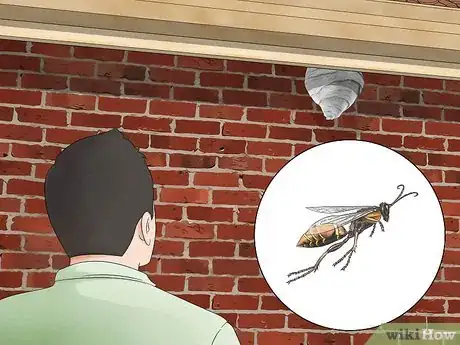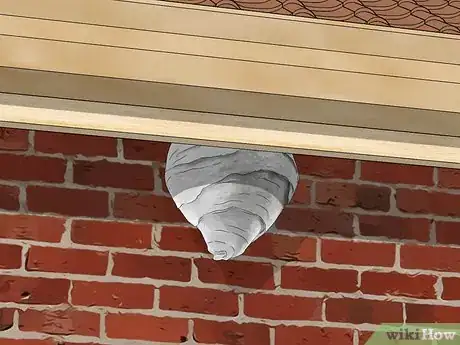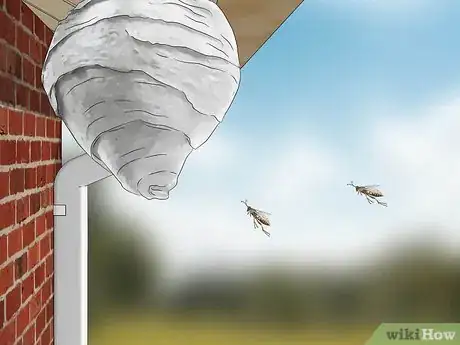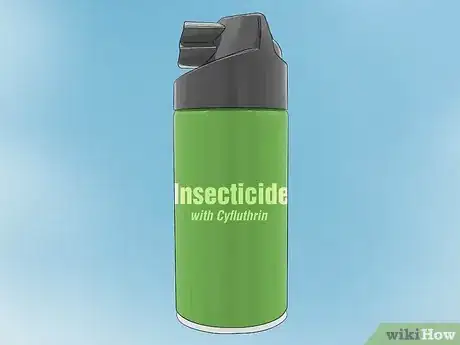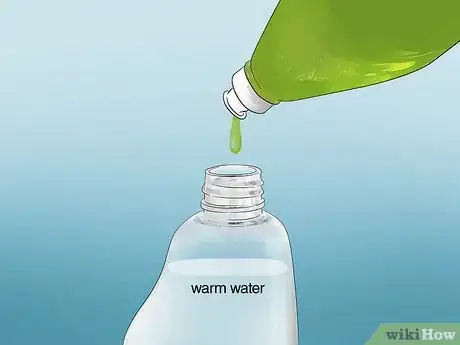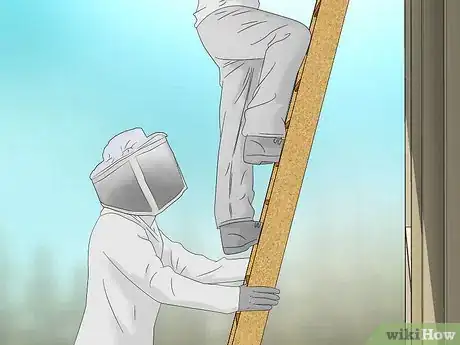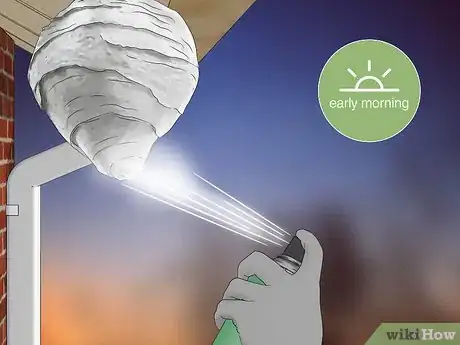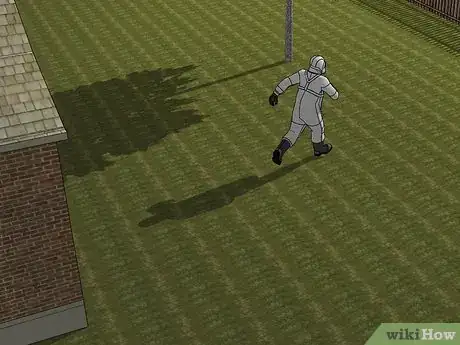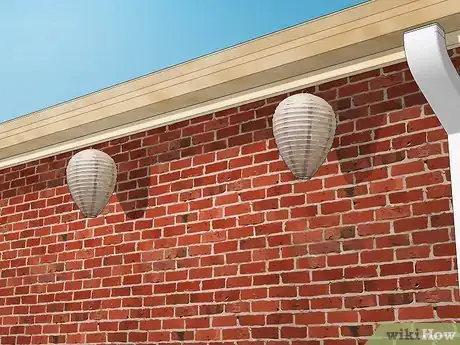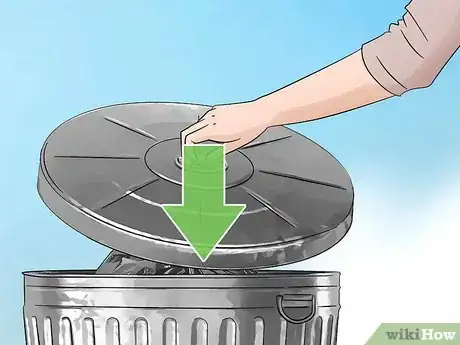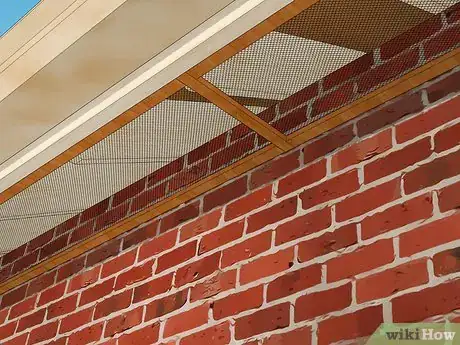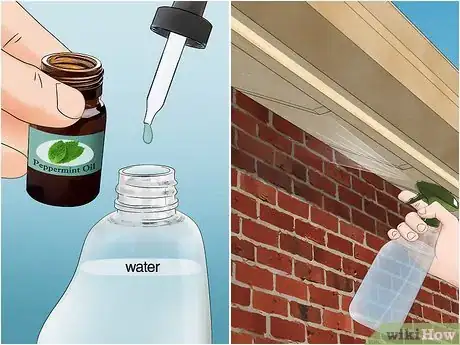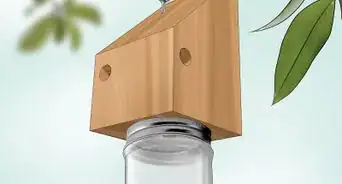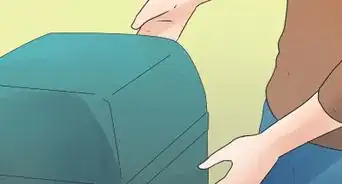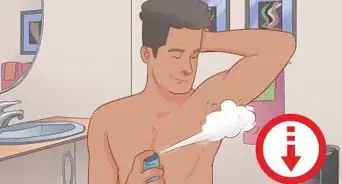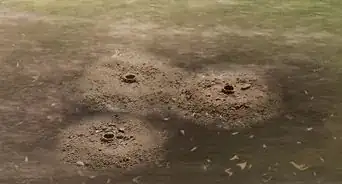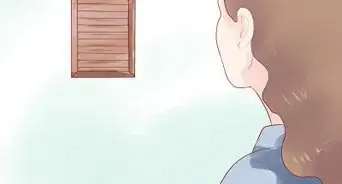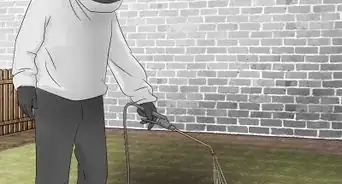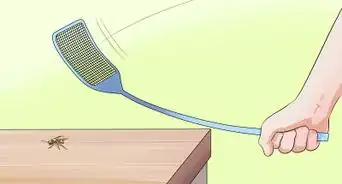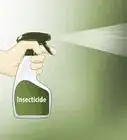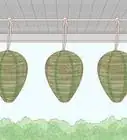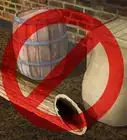This article was co-authored by Luke Lewis and by wikiHow staff writer, Jennifer Mueller, JD. Luke Lewis is a Pest Management Expert and the Founder and President of Native Pest Management. Luke has led his company for over 7 years and specializes in pet-friendly and eco-friendly pest control, termite control, and lawn care. Native Pest Management was named as one of Inc. Magazine’s 5000 fastest growing companies in America. Luke holds both BS and MS degrees from the University of Florida and is a graduate of UF's Pest Management University.
There are 11 references cited in this article, which can be found at the bottom of the page.
This article has been viewed 7,891 times.
Paper wasps are actually beneficial insects that prey on various pests that can damage your garden—but you're probably more worried about getting stung. If you'd rather not have that threat hanging over your spring and summer backyard fun, it's fairly easy to get rid of them.[1] Although paper wasps don't reuse old nests, they will keep coming back to a favorite spot over and over. After you get rid of the nest, use preventive measures to keep them from returning.[2]
Steps
Identification
-
1Watch the nest from a distance to confirm you're dealing with paper wasps. Different bees and wasps require different control methods, so you want to make sure this is a paper wasp nest. Look for skinny brown or black wasps—they might have yellow or red markings as well. Adults tend to be less than 1 in (2.5 cm) long.[3]
- Yellowjackets are often confused for paper wasps. Yellowjackets have yellow stripes on their bodies and their nests are closed, rather than exposed like a paper wasp's nest.[4]
- If you see bees flying in and out of the nest, rather than wasps, call a beekeeper to remove the nest rather than trying to destroy it or kill the bees.
-
2Look for an exposed grey nest, usually in a sheltered location. Paper wasp nests sometimes have an umbrella shape. They're typically built under the eaves of a building or in a similarly sheltered location and the brood cells are completely visible underneath.[5]
- Paper wasp nests are usually pretty small. At maximum size, they may only house a dozen or so worker wasps.[6]
- If the nest is larger and the cells are covered in a layer of pulp, you're more likely dealing with a yellow jacket or bald-faced hornet nest. These are better left to professional exterminators.
- Consider the location and accessibility of the nest as well. You're going to have to get fairly close to it to spray it, so if it's high up, it might not be something you want to do by yourself.[7]
Advertisement -
3Hire a professional exterminator if you're allergic to wasp stings. Taking all the precautions in the world doesn't guarantee you won't get stung. Wasps typically don't sting unless you're threatening their colony, but if you're trying to destroy their nest, that's exactly what you're doing.[8]
- Wasp stings can be painful but aren't dangerous unless you're allergic. How painful? Entomologist Justin Schmidt rated it a 1.5 out of 4.0 on his sting pain index, the equivalent of a single drop of superheated frying oil splattering on your skin.[9]
- Keep in mind that bees and wasps have different venom, so having an allergic reaction to bee stings doesn't necessarily mean you'll also be allergic to wasp stings. At the same time, it's usually better to err on the side of caution and not try to get rid of that nest yourself.
Destroying the Nest
-
1Leave the nest alone if it doesn't pose a danger to anyone. Paper wasps are beneficial insects that feed on a lot of other insects people consider pests. If the nest is out of the way in a place where people seldom go, you can safely ignore it.[10]
- The time of year plays a role in this as well. If it's September or October, there's really no point in spraying the nest—the first hard frost will kill them. Just wait until then and knock it down.
-
2Buy an aerosol insecticide with an active ingredient that ends in "-thrin." You shouldn't have any problem finding an aerosol insecticide for wasps anywhere pest control supplies are sold locally, such as a discount or hardware store. Look at the list of active ingredients—ones with Cyfluthrin, D-trans Allethrin, or Phenothrin will be best for killing wasps quickly.[11]
- These chemicals are also good to use because sun and water break them down, so they won't be hanging around in the environment for very long.
- Some cans may have the word "Danger" on the front, while others say "Caution." Start with a "Caution" product—they're the least toxic. "Danger" products are extremely toxic, even to humans. Products that say "Warning" have toxicity levels in between "Danger" and "Caution" products.
-
3Mix up a spray bottle of soapy water as an alternative to insecticides. Insecticides can be pretty toxic and have their own dangers. If you'd rather not deal with them, you're in luck! Just squirt a little dish soap into a spray bottle of warm water and use that to soak the nest.[12]
- It might sound too simple to be true, but soapy water really will kill wasps. You just need to make sure you completely soak the nest and the wasps inside. It might take a few rounds to completely get rid of them this way.
-
4Clear an escape path in case the wasps swarm. Ideally, the wasps will be dormant in the evening and not come after you—but you still want to be prepared. Carefully remove anything that might get in your way if you need to exit the area quickly.[13]
- If you've never done this before, you might want to do a quick practice run, without actually spraying the nest, just to make sure you've got it all down and know what you're going to do. That'll help keep you from panicking if some wasps do fly out of the nest when you spray it.
-
5Suit up in protective clothing before you go out to the nest. Wear long sleeves and long pants—basically, try to cover as much skin as possible. If the wasps want to sting you, they'll go for exposed skin first.[14]
- A helmet with a screen or mesh face covering, similar to those beekeepers wear, will protect your head, face, and neck. If you don't have anything like that lying around, do the best you can with a hat and face mask.
- Tucking your pants into your socks will keep them from riding up and exposing your ankles and calves.
- Wear rubber gloves if you're using an insecticide, at least on the hand you're going to spray with—you don't want the toxic chemicals to get on your hands.[15]
-
6Recruit an assistant if you're going to be on a ladder. Paper wasps like to build their nests up high, such as under the eaves of the house. If you need a ladder to get close enough to the nest to spray it, have someone on the ground holding it for you. Hook the bottle to your belt or have your assistant hand it up to you after you've reached the appropriate height.[16]
- Wear shoes with slip-resistant soles when you're going to be climbing a ladder to minimize the risk of falls.
- Make sure you've placed the ladder close enough to the nest that you don't have to overreach and upset your balance. If you're leaning off from the side of the ladder, you could easily fall off.
-
7Spray the nest in the early evening. At dusk, most (if not all) of the wasps in the colony will have returned to the nest. Stand about 20 feet (6.1 m)away, to the side of the nest (never directly under it), and spray directly on it to soak the entire nest.[17]
- Make sure there's enough general light in the area that you can see the nest you're spraying. If you need a flashlight, be careful not to shine it directly on the nest, which will disturb the wasps. It helps to cover the beam in red cellophane since insects can't see red light.
- If you're using an insecticide, it's usually best to do this on a calm night when there's not a lot of wind. If you can't avoid a breeze, at least make sure it's not blowing towards you—it'll blow the insecticide right back in your face.[18]
- Because paper wasp nests are open and exposed, this should be all you need to do to kill the wasps living inside.[19]
- Caution must be exercised always, since some species are quite active at night and all species will swarm to defend the colony even at night.
-
1Leave the area immediately after you finish spraying the nest. If all the wasps are inside the nest, there won't be anything for you to watch while the insecticide does its work. You don't want to be around if any wasps happen to fly out, though.[20]
- Follow the escape route you already cleared and get back inside as soon as possible.
-
2Wait overnight for the insecticide to dry and the wasps to die. Remove your gloves as soon as you come inside and throw them away. You probably want to change clothes too, especially if you had any of the insecticide blow back on you. Most insecticides will kill the wasps in the nest within a few hours, but you want to wait overnight to be safe. It's easier to knock the nest down in the daytime anyway.[21]
- If you still see activity the next day, repeat the spray treatment again that evening before you attempt to knock down the nest.[22]
Keeping Wasps from Coming Back
-
1Knock the nest down with a long-handled tool so wasps don't return. Use a rake or hoe to knock the nest onto the ground. The long handle ensures you can keep a safe distance in case there are still active wasps hanging around inside. Once the nest is on the ground, spray it again with insecticide to make sure all pieces are saturated.[23]
- Leave the nest until the insecticide has dried (any wasps that happened to be away won't come back to it). You don't want to touch the nest while the insecticide is wet.[24]
-
2Hang a fake wasp nest in the area to deter others. Buy a fake wasp nest online or at any store that sells pest control products. All you have to do is hang it in the area where you had a wasp nest before. Wasps are pretty territorial, so they won't go in that area if they see another wasp nest.[25]
- Keep in mind a fake wasp nest won't necessarily keep wasps from building a nest in another part of your yard or on the other side of your house. You'll still need to keep an eye out in spring and early summer.
-
3Knock out new nests early before they grow. When nests first start, they're tiny and may only have a handful of brood cells. As long as you take the same precautions as you would with larger nests, they're usually easier to get rid of at the early stages.[26]
- Keep in mind that if you destroy a nest, the wasps may return to the same spot and try to build another one. Stay vigilant and use other preventive measures to make the area less attractive.
-
4Remove potential food sources and open garbage cans. Wasps are attracted to rotting food and garbage, as well as piles of rubbish or wood that attract the insects they feed on. Keep these areas clean and seal the lids on your garbage cans if you leave them outside.[27]
- Any time you eat outside, clean up the food scraps immediately—don't let them rot on the ground.
- Wasps might also be attracted to pet food you leave out or scraps you leave out for other animals.
-
5Screen openings and vents where wasps like to nest. Paper wasps often like to build their nests in small openings between gutters and eaves or inside vents. Buy mesh screening online or at a hardware store and attach it to the inside of these openings to keep them from getting in. Problem solved![28]
-
6Paint or varnish exterior surfaces. A fresh coat of paint or varnish leaves a slick surface that wasps are going to have a hard time getting their building materials to stick to. This means they aren't going to be able to build their nest on that surface.[29]
- After you remove a wasp nest, clean the immediate area, then go over it with a spot coat of paint or varnish. That makes that specific area less attractive without you having to paint your whole house.
-
7Spray diluted peppermint oil to repel wasps. A lot of different products are marketed as wasp repellents. Unfortunately, most of them don't actually work. However, a scientific study found peppermint oil has a strong repellent effect on wasps. You can buy commercially formulated peppermint oil sprays or mix your own with a few drops of essential oil in water.[30]
- This is a treatment you'll have to keep doing regularly for continued results. Over time, the peppermint oil will evaporate and lose its power (unless the rain washes it off first).
Warnings
- If you get stung by a wasp and have swelling in your throat or difficulty breathing, call emergency services immediately—you're experiencing a life-threatening allergic reaction.[31]⧼thumbs_response⧽
- When you use an insecticide, read and follow the instructions on the label carefully, even if they differ from the instructions in this article. It's illegal to use an insecticide in any way other than as listed on the label.⧼thumbs_response⧽
- Insecticides are highly toxic! Store them in a climate-controlled area out of children's reach.[32]⧼thumbs_response⧽
References
- ↑ https://extension.umn.edu/yard-and-garden-insects/wasps-and-bees
- ↑ https://www.canr.msu.edu/news/getting_rid_of_wasps_nests
- ↑ https://extension.umn.edu/yard-and-garden-insects/wasps-and-bees
- ↑ https://agrilifeextension.tamu.edu/library/insects/paper-wasps-yellowjackets-and-solitary-wasps/
- ↑ https://extension.psu.edu/getting-rid-of-paper-wasps-and-yellow-jackets
- ↑ https://www.canr.msu.edu/news/getting_rid_of_wasps_nests
- ↑ https://www1.nyc.gov/site/doh/health/health-topics/wasps.page
- ↑ https://extension.umn.edu/yard-and-garden-insects/wasps-and-bees
- ↑ https://www.nhm.ac.uk/scroller-schmidt-painscale/#6
- ↑ https://extension.umn.edu/yard-and-garden-insects/wasps-and-bees
- ↑ https://extension.psu.edu/getting-rid-of-paper-wasps-and-yellow-jackets
- ↑ https://www2.illinois.gov/dnr/OI/Pages/BPTheAfternoontheWaspsWentDown.aspx
- ↑ https://extension.umn.edu/yard-and-garden-insects/wasps-and-bees
- ↑ https://extension.umn.edu/yard-and-garden-insects/wasps-and-bees
- ↑ https://extension.psu.edu/getting-rid-of-paper-wasps-and-yellow-jackets
- ↑ https://www.americanladderinstitute.org/page/BasicLadderSafety
- ↑ https://www.clemson.edu/extension/beekeepers/fact-sheets-publications/paper-wasps.html
- ↑ https://extension.psu.edu/getting-rid-of-paper-wasps-and-yellow-jackets
- ↑ https://www.canr.msu.edu/news/getting_rid_of_wasps_nests
- ↑ https://www.canr.msu.edu/news/getting_rid_of_wasps_nests
- ↑ https://extension.psu.edu/getting-rid-of-paper-wasps-and-yellow-jackets
- ↑ https://extension.umn.edu/yard-and-garden-insects/wasps-and-bees
- ↑ https://www.canr.msu.edu/news/getting_rid_of_wasps_nests
- ↑ https://extension.psu.edu/getting-rid-of-paper-wasps-and-yellow-jackets
- ↑ https://www.goodhousekeeping.com/home/a20707173/wasp-proof-your-yard/
- ↑ https://www.goodhousekeeping.com/home/a20707173/wasp-proof-your-yard/
- ↑ https://www.goodhousekeeping.com/home/a20707173/wasp-proof-your-yard/
- ↑ https://www.clemson.edu/extension/beekeepers/fact-sheets-publications/paper-wasps.html
- ↑ https://www.clemson.edu/extension/beekeepers/fact-sheets-publications/paper-wasps.html
- ↑ https://www.ncbi.nlm.nih.gov/pmc/articles/PMC4592629/
- ↑ https://extension.umn.edu/yard-and-garden-insects/wasps-and-bees
- ↑ https://extension.psu.edu/getting-rid-of-paper-wasps-and-yellow-jackets
